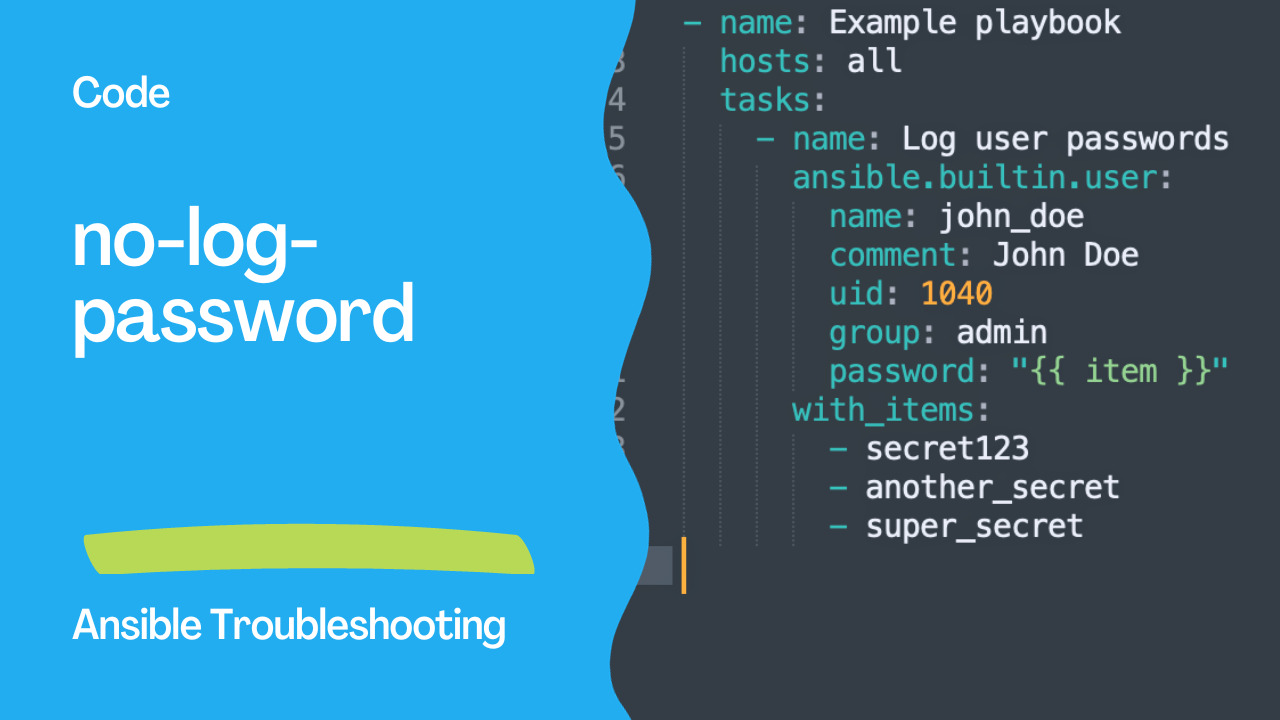Introduction
In the world of IT automation and configuration management, security is paramount. One crucial aspect of security is safeguarding sensitive data, especially passwords. Ansible, a powerful automation tool, takes this concern seriously and provides a way to protect your secrets.
However, there’s a common pitfall that can potentially expose sensitive information in Ansible playbooks when using loops. This issue is addressed by Ansible Lint’s “no-log-password” rule, which checks if playbooks inadvertently write passwords to logs, potentially putting your system’s security at risk.
The Problem: Logging Passwords
Let’s explore why this rule exists. In Ansible, it’s common to use loops to perform repetitive tasks. For instance, you might need to create multiple user accounts, each with a unique password. The playbook might look like this:
---
- name: Example playbook
hosts: all
tasks:
- name: Log user passwords
ansible.builtin.user:
name: john_doe
comment: John Doe
uid: 1040
group: admin
password: "{{ item }}"
with_items:
- secret123
- another_secret
- super_secret
At first glance, this seems perfectly fine. You’re creating a user account with different passwords, and you’re using a loop to make it more efficient. However, there’s a hidden danger here.
The problem arises when these passwords are logged. In this example, if your playbook logs its execution, you might inadvertently expose sensitive data. While Ansible tries to mask sensitive information, it might not be foolproof, especially within loops.
Note: Ansible provides an option to automatically fix for a selection of modules for the “fqcn” error using the ansible-lint --fix option, which can be a helpful tool in resolving this issue in your playbooks.

The Solution: no_log: true
To prevent this inadvertent exposure of passwords, Ansible provides a straightforward solution: setting the no_log attribute to true. This attribute tells Ansible not to log the data, ensuring your secrets remain hidden.
Here’s the corrected code:
---
- name: Example playbook
hosts: all
tasks:
- name: Do not log user passwords
ansible.builtin.user:
name: john_doe
comment: John Doe
uid: 1040
group: admin
password: "{{ item }}"
with_items:
- secret123
- another_secret
- super_secret
no_log: true
In this revised playbook, you’ve added no_log: true to the task, making sure the sensitive password data won’t appear in logs. This small change significantly enhances the security of your playbook.
Conclusion
The “no-log-password” rule in Ansible Lint is a valuable tool for maintaining the security and integrity of your Ansible playbooks. By reminding you to use no_log: true within loops, it helps you avoid unintentionally exposing sensitive data. This simple practice can go a long way in securing your automation workflows and ensuring your organization’s data remains protected. So, the next time you’re working with loops and sensitive data, remember to use no_log: true, and keep your secrets safe.
Academy
Learn the Ansible automation technology with some real-life examples in my
Udemy 300+ Lessons Video Course.

My book Ansible By Examples: 200+ Automation Examples For Linux and Windows System Administrator and DevOps

Donate
Want to keep this project going? Please donate
